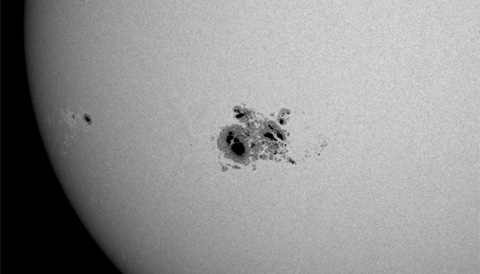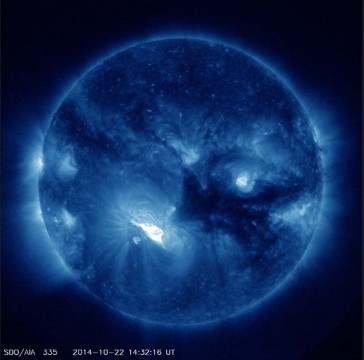A gigantic cluster of sunspots, which rotated into view on October 17th, has become as large as Jupiter and could trigger potent solar storms in the days ahead.

NASA / SDO
As soon as it rotated into view on October 17th, perched on the Sun's eastern limb, it was clear that Active Region 12192 meant business. Since then this enormous sunspot group (abbreviated AR 2192) has only gotten larger and more impressive — even menacing. Today's spacecraft images revealed a huge disturbance as large as Jupiter.
"It continues to grow in size and complexity," observes C. Alex Young, a solar specialist at NASA's Goddard Space Flight Center.
While sentry spacecraft like the Solar and Heliospheric Observatory and Solar Dynamics Explorer continue to track AR 2192, now nearing the middle of the Sun's disk, high-resolution instruments on Japan's Hinode spacecraft and at ground-based observatories have zeroed in on the big group.

NASA / SDO
It's already been the source of several outbursts, including an X-class flare two days ago. Indeed, a group of solar physicists (colorfully dubbed the Max Millennium Chief Observers) has issued a "major flare watch" for this region.
Their expectation is that AR 2192 will erupt at a level of at least M5, and perhaps X1 or greater, in the days ahead. And, in fact, that expectation proved correct, as a powerful X1.6 flare (shown below) erupted into view at about 14:30 Universal Time on October 22nd.

NASA / SDO
Space-weather forecasting is a tricky business. Just last month a powerful flare was propelled directly toward Earth, only to fizzle upon arrival. (Blame the blast's magnetic field, which wasn't oriented in a way that could readily couple with Earth's magnetosphere and allow easy entry for solar-wind particles.)
Given that AR 2192 is situated near the solar equator, today's strong outburst could send a solar blast wave squarely in Earth's direction. Is a major geomagnetic storm in our immediate future? Wouldn't you like to have a nice auroral display in dark, moonless skies this weekend?
Could Earth ever fall victim to a "solar superstorm"? Gets the odds of that happening — and the consequences if it does — in the February 2011 issue of Sky & Telescope.
 2
2
Comments
October 22, 2014 at 11:18 pm
Great update, Kelly. Here in Maryland, Howard Astronomical League is hoping for clearing skies for Thursday afternoon for our eclipse observing event at the Howard County Conservancy. Some aurorae this far south would be cool.
You must be logged in to post a comment.
October 27, 2014 at 9:33 pm
I constructed a solar filter for my 10" SCT in time for the eclipse of Oct 23, so I have only had a few weeks to immerse myself in solar science. I have been fascinated by the variety of shapes and sizes of the spots. I saw 2192 the morning of the 23rd, and was impressed but had no way of knowing whether this was unusually large or just typical. I have been thrilled to find the superb real time web sites available, particularly the SOHO research satellite. Part of the satisfaction of amateur astronomy for me is the easy link between a backyard observation and the science of the most sophisticated technology available.
The article clarified many questions I had regarding this particular phenomenon. Many thanks!
You must be logged in to post a comment.
You must be logged in to post a comment.